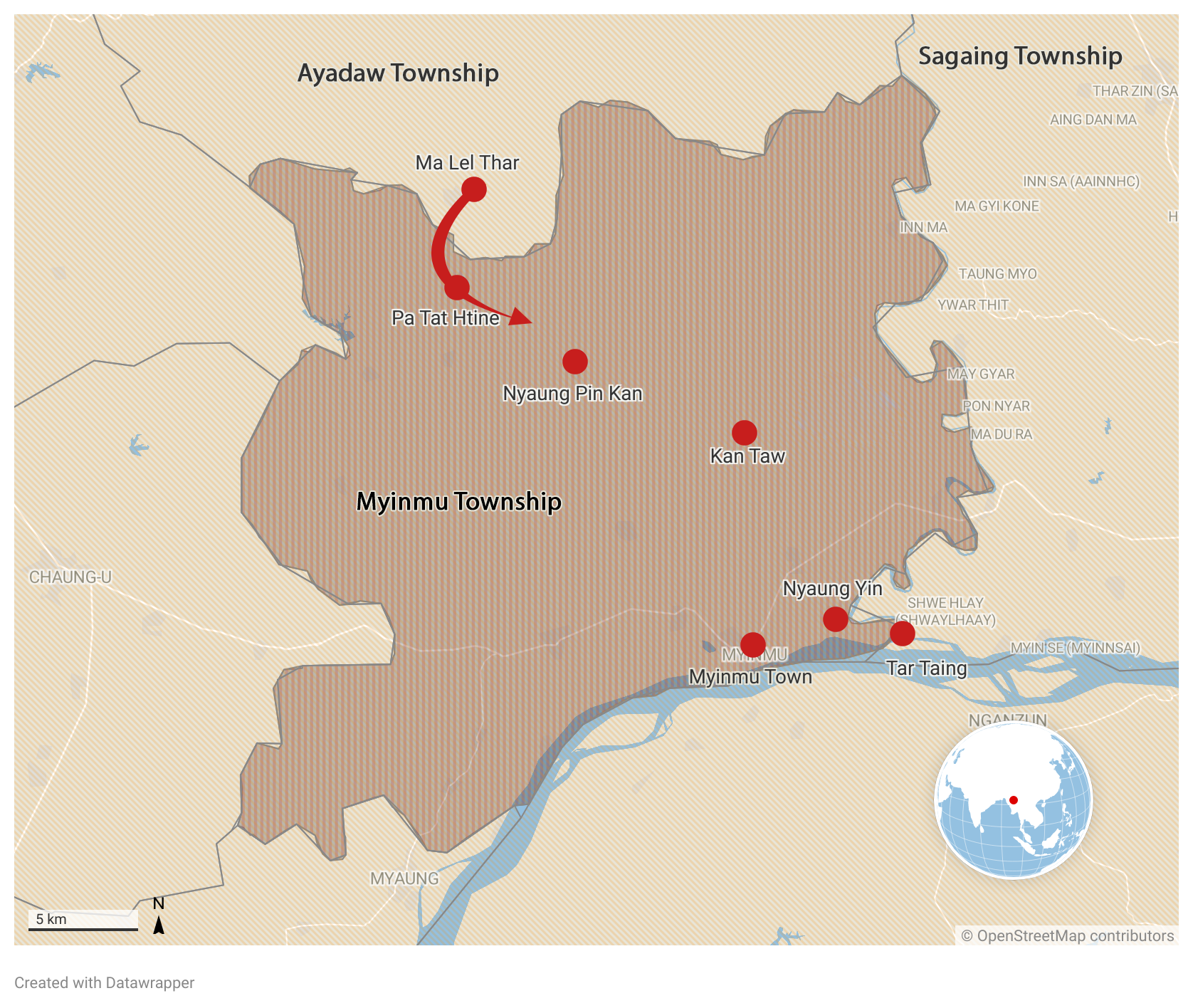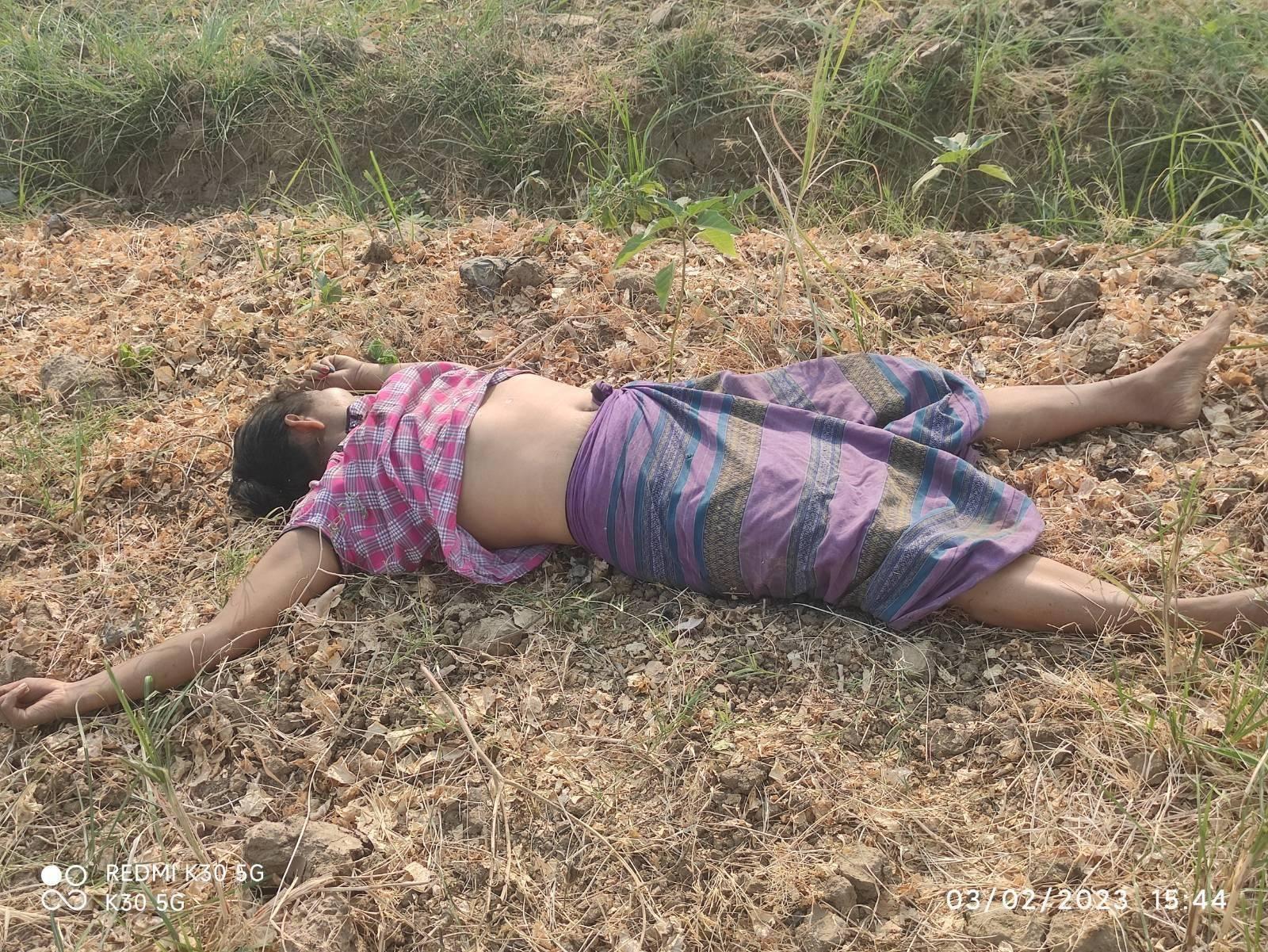Warning: Graphic Content
Myanmar’s junta is employing a special task force accused of beheading, mutilating and raping victims in its attempts to crush resistance in the country’s anti-coup stronghold of Sagaing Region, according to locals and resistance fighters.
In a series of raids from February 23 to March 5 in Ayadaw, Myinmu and Sagaing townships in Sagaing, a task force of around 100 regime soldiers under the Myanmar military’s Division 99 killed and beheaded 20 resistance members and massacred 16 civilian detainees, including three women who were raped before being killed.

People’s Defense Forces (PDFs) who clashed with the task force said that the soldiers seemed to be focused on wiping out members of the resistance. The PDFs said that the junta troops in the task force were very different to the ones they had encountered before, who tended to flee in the face of resistance attacks.
“It was hard to fight them as they were commandos and dared to raid our areas without worrying about losing their lives,” said Ko Thet Gyi, the leader of Zero Guerrilla Force which helped defend Kan Taw Village, one of ten villages raided by the task force.
The resistance leader said that the junta soldiers decapitated detained PDF fighters and chopped limbs off a resistance leader to scare people away from becoming involved in the anti-regime movement.
News of the latest atrocities committed by the junta comes less than a month after the regime imposed martial law in 14 of Sagaing’s townships, as well as in 26 other townships across four states and three regions.
The task force began its barbarous raids on February 23, after being airlifted into the region by helicopter from the base of North West Military Command in Monywa. The regime soldiers raided and occupied Ma Lel Thar Village in southern Ayadaw Township the same day, while MI-35 helicopter gunships attacked the village, said resistance groups.
At the same time, heavy clashes were taking place in a nearby village between junta troops and a combined force of PDFs.
On February 24, the task force raided and torched houses in Pa Dat Htine Village in nearby Myinmu Township, as well as killing a resistance fighter. On the following day, the task force raided and occupied Nyaung Pin Kan Village and a neighboring village.
A 10-hour firefight then broke out on February 26, when seven PDFs defended Kan Taw Village, a resistance stronghold, in Myinmu Township against the task force.
The junta task force had earlier abducted seven civilians, including two teenage resistance fighters from Acid Army Defense Force, from Nyaung Pin Kan Village to use as human shields and guides during the raid.
After coming under attack from the PDFs, the regime troops decapitated the two resistance fighters at a monastery just outside the village, which they then torched, according to Zero Guerilla Force leader Ko Thet Gyi.
Military regime troops placed the head of one decapitated resistance member on a fence and left the head of the other PDF fighter on a table at the monastery, while destroying Zero Guerilla Force’s temporary camp.
The junta task force occupied Kan Taw Village for one night, leaving on February 27. The soldiers also killed and beheaded another two resistance fighters defending the village.
At around 3am on March 1, the task force raided and occupied Tar Taing Village near the confluence of the Ayeyarwady and Mu rivers in neighboring Sagaing Township.
During the raid U Kyaw Zaw, the leader of the village defense force, was detained and killed. Another PDF member and a villager were also killed, while 70 villagers were detained.

“Around 70 villagers were locked in a monastery building along with three monks. Some detainees were severely beaten after being taken away from the monastery,” a Tar Taing villager named U Myint, who escaped the junta raid, said in an online press conference held by the civilian National Unity Government (NUG).
Resistance leader U Kyaw Zaw was beheaded and his legs and arms were chopped to pieces, while he was also knifed in the stomach.
Two firefights broke out when PDFs surrounded the village in an attempt to rescue the civilian detainees, according to PDFs that took part. But the regime task force was able to occupy the village for the night.
Citing reports from military informants, the leader of Tike Nal Swon PDF, which took part in the Tar Taing clashes, told The Irrawaddy that the junta task force is made up of commandos tasked with killing resistance leaders and civilians whose names they get from lists of PDF groups.
For that reason, the task force has only been raiding villages that are known to be resistance strongholds.
On March 2, 14 Tar Taing villagers including three females were taken as human shields, along with other villagers detained in nearby villages.

Residents and resistance fighters subsequently discovered the 14 bodies of the Tar Taing villagers on a sandbank and in a mango plantation near Yaung Yin Village outside Myinmu Town, according to PDFs who spoke with The Irrawaddy.
Resistance fighters and locals retrieve the bodies of Tar Taing villagers killed by junta troops and dumped outside Nyaung Yin Village in Myinmu Township on March 2. Video/ Demon King Defence Force
All the victims had been beaten around their heads before being shot. The three female victims were raped, before being stabbed and shot.
“Their faces and heads were badly damaged by the beatings before they were shot. It hurt us a lot to see the dead bodies. The most atrocious thing is that the three women had been abused before being killed,” said Tar Taing villager U Myint who saw the bodies of the victims.

Another Tar Taing villager Ko Naing Thu Aung, who lost his mother, a brother, an aunt and a brother-in-law in the raid, said at the NUG’s online press conference: “I thought they [regime troops] would not kill hostages and women. But they killed all my family members.”
He appealed to the international community to protect the people of Myanmar from the military regime.
“I want no more families and civilians to be killed by the junta,” said Ko Naing Thu Aung.
The regime task force raided Nyaung Yin Village on March 2 and also shot dead a civilian on a motorbike after being ambushed with landmines by the People’s Army to Fight Dictatorship PDF outside Myinmu Town.

Four soldiers were killed in the ambush, while others were injured, according to the PDF leader. A PDF video shows the task force carrying injured soldiers as it entered Myinmu Town on March 2.
Two days later, the task force raided Lat Ka Pin Village in western Myinmu Township, detaining 200 residents.
Citing the village defense force, a PDF leader told The Irrawaddy on Friday that the task force killed a total of 13 resistance fighters including seven from Mandalay Region who were sheltering at the village’s monastery.
The Mandalay PDF fighters were shot dead at the monastery, while the other six local PDF members were killed and dumped outside the village. One had been stabbed and beheaded.
Regime troops also detained a monk along with several villagers.
After the raid, the task force is believed to have moved to Myaung Township.
NUG human rights minister U Aung Myo Min said during a recent meeting with a Czech government representative that the junta is killing civilians including children because it sees them as the enemy of the state.
“The situation right now is going beyond human rights violations. I would say that it is democide. It is more than genocide,” said U Aung Myo Min.

















